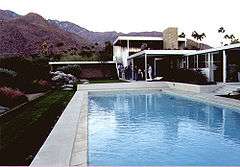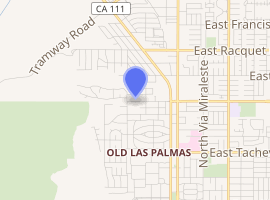Kaufmann Desert House
The Kaufmann House (or Kaufmann Desert House) is a house located in Palm Springs, California, that was designed by architect Richard Neutra in 1946.
| Kaufmann Desert House | |
|---|---|
 Kaufmann Desert House, November 2000 | |

| |
| General information | |
| Status | Complete |
| Architectural style | International |
| Location | 470 West Vista Chino Palm Springs, California United States |
| Coordinates | 33.8451°N 116.5529°W |
| Completed | 1946 |
| Design and construction | |
| Architect | Richard J. Neutra |
It was one of the last large-commission domestic projects designed by Richard Neutra, but it is also arguably one of his most architecturally noteworthy and famous homes.
It is "one of the most important examples of International style architecture in the United States and the only one still in private hands", and in 2008 was offered for sale.[1]
Description
This five-bedroom, five-bathroom vacation house in Palm Springs, was designed to emphasize connection to the desert landscape while offering shelter from harsh climatic conditions. Large sliding-glass walls open the living spaces and master bedroom to adjacent patios. Major outdoor rooms are enclosed by a row of movable vertical fins that offer flexible protection against sandstorms and intense heat.
A combined living and dining space, roughly square, lies at the center of the house. While the house favors an east-west axis, four long, perpendicular wings extend in each cardinal direction from the living areas. Thoughtful placement of larger rooms at the end of each wing helps define adjacent outdoor rooms, with circulation occurring both indoors and out.
The south wing connects to the public realm and includes a carport and two long, covered walkways. These walkways are separated by a massive stone wall and lead to public and service entries, respectively. The east wing of the house is connected to the living space by a north-facing internal gallery and houses a master bedroom suite. To the west, a kitchen, service spaces, and staff quarters are reached by a covered breezeway. In the northern wing, another open walkway passes along an exterior patio, leading to two guest rooms.
History
The home was commissioned by Edgar J. Kaufmann, Sr., a Pittsburgh department store tycoon as a desert retreat from harsh winters, and was built in 1946. It was made famous by the 1947 photos by Julius Shulman.[2] A decade earlier, Kaufmann commissioned Frank Lloyd Wright to build Fallingwater in Pennsylvania.
After Kaufmann died in 1955, the house stood vacant for several years. It then had a series of owners, including singer Barry Manilow and San Diego Chargers owner Eugene V. Klein,[3] and had several renovations. These renovations enclosed a patio, added floral wallpaper to the bedrooms and removed a wall for the addition of a media room; additionally, the roof lines were altered with the addition of air conditioning units. In 1992, the home was rediscovered and purchased by a married couple: Brent Harris, an investment manager, and Beth Edwards Harris, an architectural historian; at the time it had been for sale on the market three and a half years.[2]
The Harrises purchased the home for US$1.5 million, then sought to restore the home to its original design. Neutra died in 1970 and the original plans were not available, so the couple brought in Los Angeles architects Leo Marmol and Ron Radziner to restore the design.[4] For clues to the original design, the Harrises looked through the extensive Neutra archives at UCLA, found additional documents through Columbia University and were able to work with Shulman to access some of his never-printed photos of the home's interior. They were able to obtain pieces from the original suppliers of paint and fixtures; they purchased a metal-crimping machine to reproduce the sheet-metal fascia that lined the roof.
Additionally, the Harrises were able to have a long-closed section of a Utah quarry reopened to mine matching stone to replace what had been removed or damaged. To help restore the desert buffer Neutra had envisioned for the house, the Harrises also bought several adjoining plots to more than double the land around the 3,200-square-foot (300 m2) house.
They rebuilt a pool house that serves as a viewing pavilion for the main house, and kept a tennis court that was built on a parcel added to the original Kaufmann property.[2]
After the Harrises divorced, the home was sold on May 13, 2008, for US$15 million at auction by Christie's as a part of a high-profile sale of contemporary art.[3] The house had a presale estimate of US$15 million to US$25 million.[2] The sale later fell through, as the bidder breached terms of the purchase agreement.[5]
In October 2008, the house was listed for sale at US$12.95 million.[6]
The restoration by Marmol Radziner + Associates was critically lauded.[2] Today, many critics place the Kaufmann House among the most important houses of the 20th century in the United States, with the likes of Fallingwater, Robie House, Gropius House, and the Gamble House.
The Kaufmann house was included in a list of all-time top 10 houses in Los Angeles, despite its location in Palm Springs, in a Los Angeles Times survey of experts in December 2008.[7]
References
- Judith Gura (May 1, 2008). "Richard Neutra's Kaufmann House". ARTINFO. Retrieved May 14, 2008. Cite journal requires
|journal=(help) - Edward Wyatt, A Landmark Modernist House Heads to Auction, The New York Times, October 31, 2007.
- Willian Avila, Kaufmann House sells for $15 million, The Desert Sun, May 14, 2008
- "Harris Pool House". Marmol Radziner. Retrieved July 12, 2012.
- Newman, Morris (May 2009). "Revisiting the Kaufmann House". Palm Springs Life.
- Diane Wedner (October 26, 2008). "Neutra's Modernist masterpiece". Home of the Week. Los Angeles Times. Retrieved October 28, 2008.
- Mitchell, Sean (December 27, 2008). "The best houses of all time in L.A." Los Angeles Times. Retrieved December 27, 2008.
Further reading
- Friedman, Alice T. (c. 2010). "2. Palm Springs Eternal: Richard Neutra's Kaufmann Desert House". American Glamour and the Evolution of Modern Architecture. New Haven, CN: Yale University Press. pp. 262. ISBN 978-0-300-11654-0. LCCN 2009032574.